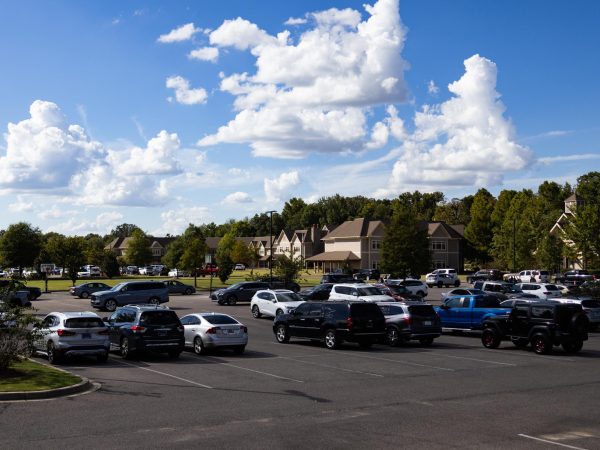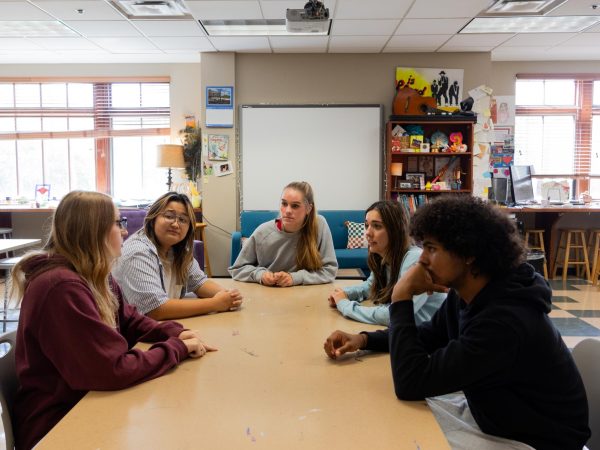Rumor Has It…
Students vouch for more communication to dispel financial rumors

As each school year starts, new students aren’t the only ones who have to adjust to change. Being undoubtedly unique from any other private school in the Memphis area, when St. George’s makes adjustments, navigating each step of the process is much more convoluted than one might think. The school is a living, breathing entity, forever changing and growing to be the best it can possibly be.
As developments are made, one of the most important repercussions is how they affect the student body. But with recent changes in the school community came outlandish rumors: rumors about financial aid, buses and even copy machines. Where did these rumors come from? Could it be that some of them are true?
To understand changes coming to St. George’s, we must first understand the school’s foundations.
St. George’s was established in 1959 as a K-6 school with a singular campus in Germantown. Families quickly grew to love the school’s accepting community, the focus on Judeo-Christian foundations and the reinforcement of character values. In fact, families were vocal about their reluctance to leave the St. George’s community as their children graduated sixth grade.
Andrea Ballard, AssistantAdmissions Director – who was teaching at the Germantown Campus at St. George’s at the time – felt “lots of pressure from our families that they didn’t want to go somewhere else.”
“So in doing some research to see: ‘could Memphis support another independent high school and have enough student body’…a donor group came forward who was trying to raise the level of education in Memphis for everyone and said, ‘We are willing to help you build the middle school and the high school if you will replicate your lower school within city limits and provide that education to families who typically could not afford an independent school education,’” Mrs. Ballard recalled.
The donors that helped fund the building of the lower school within Memphis city limits also provided matching funds to help found the Collierville campus.
Finally, in 2001, the doors to the Memphis campus opened for the first time.
Though the Memphis campus is a part of St. George’s, it operates a little differently from the Germantown and Collierville campuses.
Timothy Gibson, Head of School, explained the main difference.
“There’s a donor group that provides a significant amount of support there that is separate from the budgets of Germantown and Collierville,” said Mr. Gibson.
Mrs. Ballard expanded on that, clarifying that what families pay “is on a major scale based on what their income is” and that “families there receive typically more financial aid than they can at … Germantown and Collierville, simply because the donors earmarked that money.”
Athletic Director Will Bladt explained that in order to sustain their goal of providing independent school education to families who cannot afford it, the donor group “contribute[s] money every year.”
But that rumor was not the only one spreading. For the past four months, students and faculty passing through the fieldhouse have seen and heard the sounds of construction. Whispers about the costly renovations and concerns that they had put the school in debt spread like wildfire.
The fieldhouse project is an $800,000 renovation project that is completely donor-funded, meaning that no money was pulled out of the operating budget to fund the fieldhouse project.
Mr. Gibson explained that “the fieldhouse project… is designed to sort of provide a better experience for student-athletes but also students who are thinking about health and wellness more broadly.”
According to Mr. Bladt, St. George’s is “expanding the strength and conditioning room by 50%… putting in new state-of-the-art equipment for strength and conditioning training… [and] redoing two locker rooms. What used to be the middle school locker rooms… are now going to be varsity team rooms.”
Junior Parker McClain appreciates the efforts to expand the weight room.
“Space was one issue [in the weight room]…if there was a team in there, you’d never have space to work out individually,” he said. As a three-sport athlete, McClain is in the weight room “twice, three times a week during football season, and almost every day in other parts of the year,” and is looking forward to the new equipment.
The fieldhouse is growing, but another obvious change came to the St. George’s bus service, which used to bring students from the Memphis or Germantown campuses to the Collierville campus and then back again.
The bus service was terminated this school year, and with this change came a rumor that the school cut the bus service without reason.
Sophomore Paige Fernandez, who rode the bus daily last year, reflected on the state of the dilapidated buses.
“[The bus] would break down literally in the middle of the road last year, and we would all have to get out of the bus and sit on the sidewalk and wait for the other bus to come get us. That happened more than once. It was really embarrassing. The buses would always be in disrepair,” she said.
Following the removal of the bus services, Fernandez explained, “it’s really only affecting a small amount of people, but I feel like it’s such a big effect on the specific person’s life.”
Fernandez emphasized that some members of our community “are here on financial aid” and can’t afford alternative modes of transportation, “and taking away the bus is, I feel like, a jab directly at those people.”
Mr. Gibson urged students not to think that we “cut” buses.
“We had buses that had reached the end of their lifespan coupled with an inability to find bus drivers,” he said. “You can’t…just drive a bus… It takes a specific license that is hard to get. And as there are sort of hiring issues everywhere right now… we tried for an entire year to hire bus drivers and got one bite, I think, over the course of a year, maybe.”
Regardless of the school’s reality, Fernandez’s frustration is rooted in the feeling that “it’s really mostly affecting people of low income.”
The academic building experienced its fair share of changes as well. In August, students stumbled upon a new addition to the usual hallway decor: unused copiers lining walls and gathering dust in stairwells. Noticing the strange sight, some students immediately jumped to the conclusion that St. George’s was throwing away unused copiers.
Upon hearing this rumor, Mrs. Ballard was shocked. “Gosh, Heavens, no,” she said. “We went with a new [copier] company. And the company that we were renting [the copiers] from… would only pick them up if all of the copiers were in one location. So we had to get the copiers from the Germantown campus and the Memphis campus all here.”
Mr. Gibson explained that “[the copiers] sitting in the hallways … were waiting to be picked up.” In fact, leasing copiers is a standard practice among private schools, he adds, “because that way when they become obsolete, you’ve replaced them with new ones.”
This slew of rumors has spread like a virus throughout the school, infecting students with doubt and distrust in the St. George’s administration. Like a sickness, these rumors are detrimental to the overall health of the school. So what measures can we take to heal our community?
Communication is preached as a crucial element of success. Our community is built on this idea through the expectations to check our emails, monitor Canvas and exchange ideas in class. The expectations of students are abundantly clear, but the need for communication between the ad- ministration and the student body has never felt so dire.
Students believe that establishing transparency when changes are underway within the school will lower the spread of rumors and create a more united community.
Because Fernandez’s concerns are rooted in equitable support of all St. George’s students, she emphasizes that she would be less frustrated if she knew more.
Fernandez clarified that “knowing where your money is going is a big part of [the frustration]” felt by students and families in the community.
McClain agreed, saying that “a lot of the things that the students are asking for is more transparency with the budget.”
“Knowing where the money is going, I think, would help because [students] know that there is money going into the school because of the amount of people who pay tuition and stuff—like they know that there is money going into the school—but I don’t think people are seeing where that’s going, and so I’ve actually heard… students ask for more transparency in the budget. I think that that would be one thing that would really help [students] be more confident in what’s going on,” he said.
Ballard shared that one of the most frequent comments she gets when touring families interested in St. George’s is “‘It’s such a beautiful campus!’”
These material aspects are created to, in Ballard’s words, “benefit the students and families,” but they also represent a promise of community. Because the physical features of our campus are often praised, it sparks contemplation of what it takes to fulfill that promise.
Part of that reality is a functional trust between the adults who make decisions and the students who are impacted by those decisions. With information being so scarce, it leads students to weigh the costs — both literal and otherwise — of making those promises a reality.
Without students, there would be no school. The student body isn’t asking for more power to make decisions, they only want to be allowed to understand them.
Recognizing that the students are the foundation of our community, Mrs. Ballard emphasized, “bricks and mortar don’t make a school. What makes the school is you all.”






